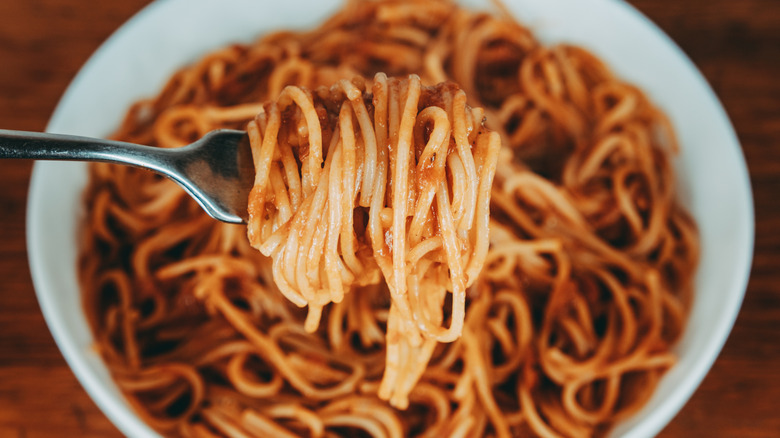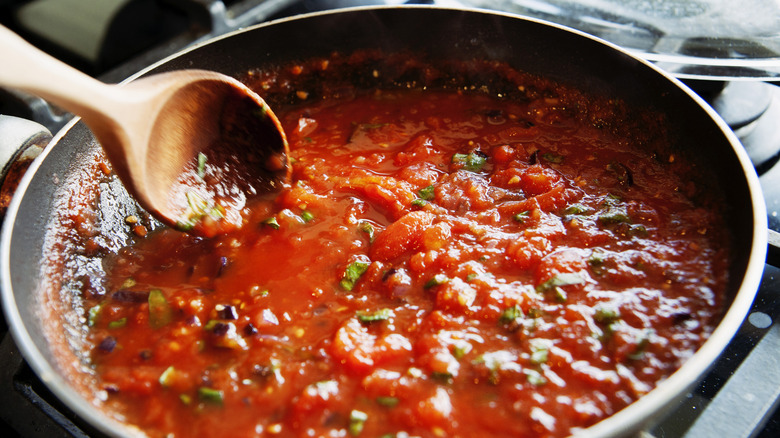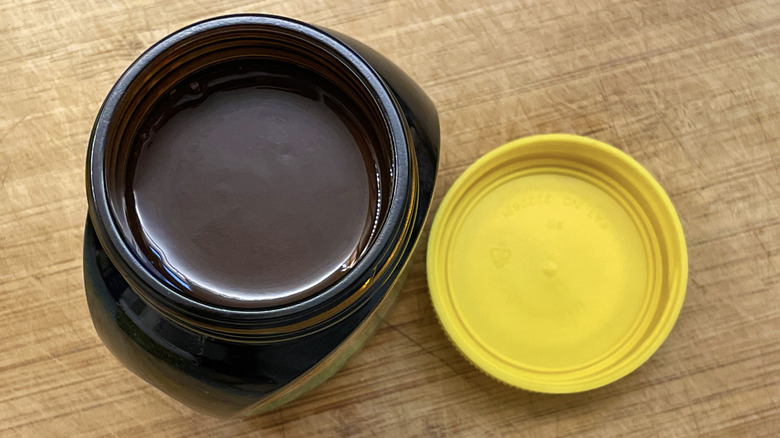The Classic British Ingredient You Need For Umami-Packed Pasta Sauce
Pasta, specifically spaghetti and fusilli, is one of my favorite comfort foods. I'm constantly experimenting and figuring out ways to make it better. I can sometimes get tired of the same standard flavor profile you get from traditional spaghetti with ground beef and tomato sauce, so I'm always game to try something new and fresh. And I don't do subtle; I love bold flavors — which brings me to this gem of an ingredient I came across after a little internet diving for new recipes.
When you're looking for ingredients to upgrade spaghetti sauce, Marmite might not be the first one that comes to mind. If you've heard of it, you'll probably know it's a classic British spread made from yeast extract, a byproduct of beer brewing, and it has a rich, salty, and umami-dense flavor. Despite the fact that many people use it to spread on toast, it's gaining attention as a secret weapon in pasta sauces.
Marmite is high in glutamate, which is responsible for the umami taste, and it complements and even enriches the natural flavors of tomatoes, cheese, and other typical pasta sauce ingredients. Although Marmite is polarizing because it has such a strong taste, when you use the dark spread very sparingly, it acts as a flavor booster. Essentially, it helps to amplify the taste of a dish and increase its savory deliciousness without going overboard and completely overshadowing the other flavors. Here's why Marmite works so well in pasta sauce, and the ingredients it pairs with best.
Why Marmite works in pasta sauce
As mentioned, Marmite has a unique flavor because of all that luscious but hard-to-define umami taste. Savory ingredients like this make dishes more satisfying by enhancing the other ingredients, kind of like MSG does, but while also adding their own flavor. In pasta sauce, Marmite's saltiness and depth provide the perfect counterbalance to creamy or acidic components like butter, olive oil, or tomatoes.
What makes Marmite particularly effective in pasta sauces is its versatility. A small amount can boost simple ingredients like garlic and parmesan, giving you a sauce with layers of flavor that feel complex but are easy to achieve. Marmite also dissolves quickly in a little hot water, so it blends seamlessly into a sauce without leaving behind a gritty texture.
The dark spread also works especially well in vegetarian pasta dishes, where the deep flavor of the umami compensates for the absence of meat. It can mimic the depth of flavor that anchovies or pancetta provide in traditional sauces, while offering the comfort of a tasty beefy stock — without the meat. It's delicious mixed with melted butter, or for a vegan option, combining Marmite with olive oil and garlic creates a rich, dairy-free alternative.
How to turn Marmite into a pasta sauce
Turning Marmite into a pasta sauce is surprisingly simple. Start by cooking your noodles of choice, and reserve some of the starchy pasta water for sauce. In a pan over low heat, melt butter or heat olive oil, then add a small amount of Marmite — a teaspoon should be enough for around four servings, but you can always add more to taste. Stir until the Marmite dissolves completely, which will give you a luxuriously glossy base.
To take it a step further, you could also toss in minced garlic, freshly grated parmesan, or a splash of cream if you're looking for a certain consistency. For a tangier sauce, try incorporating a small amount of tomato paste or lemon juice. Once the base is ready, add your cooked pasta and a few tablespoons of reserved pasta water to loosen the sauce and coat the noodles evenly.
Marmite-based pasta sauce pairs well with simple ingredients like sautéed mushrooms, spinach, or roasted vegetables. It also complements richer toppings like crispy bacon or pancetta, meatballs, or toasted breadcrumbs. And it's a great way to elevate a basic marinara sauce. Add Marmite to your arsenal, and you won't regret it; you're welcome.


